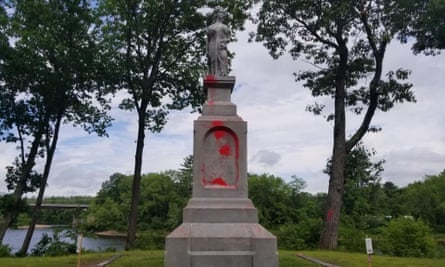Hannah Duston, subject of the first publicly funded US monument to a woman, is implicated in the deaths of 10 Native Americans

The statue is the earliest publicly funded monument to a woman in the US.
It stands in the out-of-the-way town of Boscawen, New Hampshire. It shows a woman holding a hatchet in one hand and a fistful of scalps in the other. Her name is Hannah Duston.
As protests across the US topple statues of historical figures with connections to colonialism and slavery, Duston’s name has largely stayed out of the national conversation. But concerns about the New Hampshire statue, and another in Haverhill, Massachusetts, are now emerging.
This is because Duston is implicated in the deaths, and scalping, of 10 Native Americans.
“The statues were made to send a message to the indigenous community, that they are inferior, that their land would be seized, and they would be removed and put on reservations,” Judy Matthews, a Haverhill resident, told the Guardian.

She spoke during a 30 June city council meeting in Haverhill, asking officials to consider moving the statue to a less public place.
Those who support keeping the Duston statues claim their removal alone won’t benefit indigenous people, and that Duston was acting in self-defense.
Duston was born and raised in Haverhill, then a small farming town, amid disputes among English colonists, the French in Canada, and various Native American nations. She was a homemaker with nine children, and her cousin and uncle were tried at the Salem witch trials.
She was captured by the Abenaki nation during a military engagement in 1697 with her nurse-maid and newborn and was forced to trek a great distance to an encampment in present-day Boscawen where she claimed the Abenaki killed her baby by bashing her head against a tree.
Duston, probably with the help of other captive colonists, killed the Native Americans – six of whom were children – before escaping and being generously rewarded for the scalps.
The two statues were erected in the mid-19th century to vilify Native Americans following the civil war and to promote the idea of westward expansion. Several other markers and memorials that do not bear Duston’s image were put up in Massachusetts and New Hampshire.
For decades, Abenaki, residents, scholars and local municipalities have debated what should be done with the two statues, and those concerns have come to a boil.
On 3 July, an online petition began to circulate among local social media groups calling for the removal of the statue. A counter-petition shortly followed. Ten days after Matthews spoke at the city council meeting, the monument was vandalized with the words “Haverhill’s own monument to genocide” written in chalk.
Shortly after the vandalism, Haverhill’s mayor, James Fiorentini, appointed two Native Americans to the Haverhill Historical Commission (HHC), which protects the town’s historic structures, to make recommendations for the future of the monument.
“I want to tell the other side of the story – of the Native Americans who lived here, of the immigrants who built the shoe factories, of the African Americans who were freed from slavery, and of African Americans who lived here as slaves in Haverhill,” said Fiorentini.
Yet the historical commission has not met since the start of the coronavirus pandemic and does not have a plan for when it will do so again.
Descendants of Duston, such as Diane Dustin Itasaka, who works alongside other family members at the Dustin Garrison House, are glad these conversations are happening but believe people should delve more deeply into Duston’s history before declaring that the statue must go.
“I want people to know that Hannah or any of the other women, children, babies, and men who had gone through any raid like this, if she really did do the unthinkable, it wasn’t because they were natives but because they were her captors,” claims Itasaka. “If the French had captured her, it would have been the French. It wasn’t because they were native.”
Itasaka hopes the saga will be included in the history curriculum at local schools because “if school kids or adults knew more of the history, they would understand more of how and where we are today”.
Similar conversations are happening in New Hampshire. Elizabeth Dubrelle, the head of education and public programs at the New Hampshire Historical Society, says the group made the conscious decision not to include Duston’s story in the revamped school curriculum.
That is “in part because we don’t think it’s appropriate for kids”, she said. “I think it’s way too violent. No matter whose side you take, or what you think about it, I just don’t think it’s a good story for kids.”
Unlike in Massachusetts, there is now a concrete plan to adapt the New Hampshire statue. Proposed by representatives of the Cowasuck band of the Pennacook Abenaki people and New Hampshire state officials, it was approved on 17 July.
The changes include renaming the site of the Duston statue from the Hannah Duston Memorial Site to Unity Park N’dakinna, which means “our land” in Abenaki, and adding additional signage and monuments around the statue discussing discrepancies within the story, allowing the visitor to come up with their own conclusions.
For Denise Pouliot, who is Abenaki and involved in the project, one of the most important things to come out of it might simply be reminding others of her people’s long history in the region.
“If you go out on to anywhere on the other side of the Mississippi [River] and you ask about an indigenous tribe in New England, they’ll tell you there are none,” she said. “That’s a fundamental educational problem within this country, and how are we going to move forward as a nation if even our history is so broken?”
https://www.theguardian.com/us-news/2020/aug/03/hannah-duston-statue-new-hampshire-native-americans

No comments:
Post a Comment